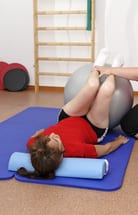Pilates

Pilates is a popular form of exercise that improves a patient's mental and physical well-being through a series of controlled movement exercises. These exercises may be performed on a mat on the floor, or with machines, and focus on strengthening and controlling the muscles of the abdomen, which provide support to the spine and can control every movement made by the body. With long-term practice, Pilates can improve flexibility, strength, endurance and coordination without adding bulky muscles, making it an ideal exercise plan for many individuals.
The Pilates method was founded in the 1920s by physical trainer Joseph H. Pilates, with the purpose of rehabilitation for soldiers returning from war. Also known as contrology, Pilates encourages the use of the mind to control the muscles and promote balance, strength and relaxation within the body. Though minor modifications have been made to the original Pilates method, the basic principles have remained the same since the method's inception many decades ago.
Benefits of Pilates
Pilates can help individuals relieve pain and feel better overall through long-term exercise programs. It can be used for the treatment of certain orthopedic conditions, or just to improve one's general health and sense of well-being. Although results may vary for each patient, Pilates is designed to:
- Create longer, leaner muscles
- Improve posture problems
- Increase strength and stability
- Prevent future injury
- Improve balance and flexibility
- Heighten body awareness
- Improve performance in sports
While many people begin Pilates as a weight loss method, there is no proven evidence that Pilates is effective in helping patients lose weight. Successfully losing weight involves burning off more calories than you consume. Pilates may contribute to weight loss by helping patients burn calories, but patients must also eat a healthy, balanced diet in order to effectively lose weight.
Key Elements of Pilates
The Pilates method is composed of several different key ideas that help improve a patient's overall well-being. Each Pilates program may differ depending on the instructor's preferences and beliefs, but most are structured around the following key elements:
Centering
Pilates focuses on the large group of muscles in our center, including the abdomen, lower back, hips and buttocks. Pilates exercises begin in these muscles and flows outwards to the extremities. The belief of Pilates is to use the center muscles for all movements of the body and rely on them for everyday living.
Control
Pilates helps patients achieve total muscle control so that movements of all body parts are smooth and intended, preventing injury and producing positive results.
Breathing
Breathing helps circulate blood and awaken cells throughout the body, preventing fatigue and improving energy levels. Breathing also helps circulate oxygen through the blood and remove waste. The breathing exercises used in Pilates encompass many of the other key elements, including precision, concentration and control to coordinate breathing with body movement.
Precision
Since every movement in Pilates has a purpose, it is important for patients to focus on perfecting one simple movement, rather than performing several movements at once. The precision practiced during Pilates eventually evolves into a natural grace.
Pilates can be practiced by most people, as exercise programs can be customized to fit each individual's body and goals. It is a safe and effective form of exercise that offers many benefits with little to no risks. Individuals can work with an experienced instructor to develop a program that is tailored to individual needs.


